If France are to have a successful Euro 2022 in England this summer, then their inspirational captain, Wendie Renard, will almost certainly be a leading light in the side as we believe she’s got a central role to play for France both on and off the pitch.
After their 2019 World Cup campaign on home soil ended in disappointment when France were eliminated by eventual winners, the United States, at the quarter-final stage, Les Bleus will be hoping to make further progress in this summer’s competition under the leadership of the hugely experienced Renard.
Background
Centre-back Renard (31), who has played her whole club career at Lyon, has had a roller-coaster international experience. She skippered her nation from 2013 to 2017 before being removed from the role after Euro 2017 but has now been re-appointed following a fall-out between previous captain, Renard’s Lyon teammate Amandine Henry, and manager Corinne Diacre.
A natural leader, Renard was the first player to reach 100 UEFA women’s club competition appearances and picked up an incredible eighth Women’s Champions League title in May after guiding Lyon to a 3-1 victory over Barcelona in Turin.
With over 30 domestic titles to her name, the Lyon captain’s experience will be vital for Diacre this summer.
It will not only be Renard’s experience that will be key for France, though. In this tactical analysis, we will take a closer look at Renard’s playing style and the technical and tactical qualities she offers.
Data Analysis
Firstly, we’ll look at Renard’s data profile for the 2021/22 domestic season.
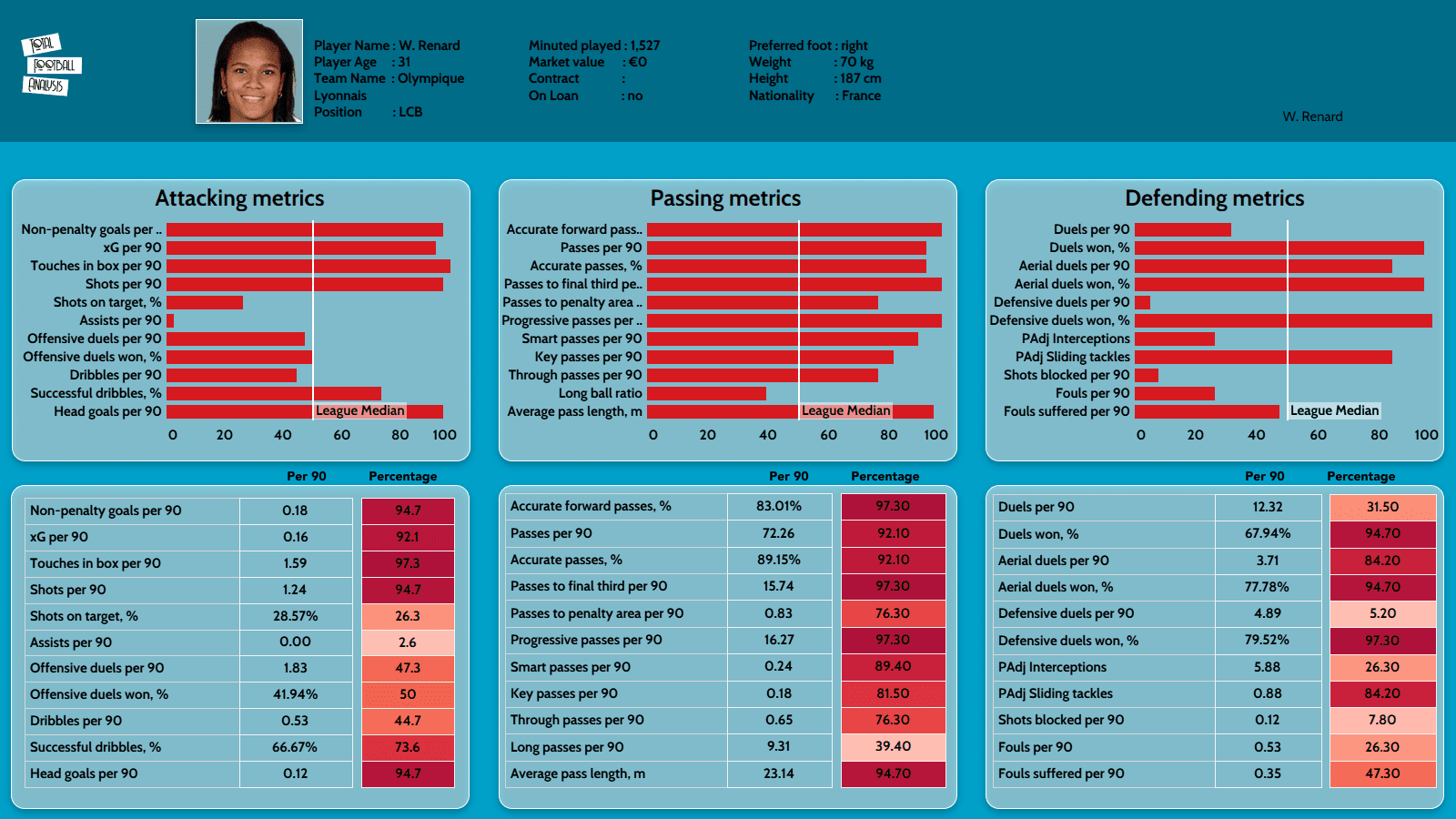
What stands out immediately in Renard’s profile are her passing metrics, scoring above the 75th percentile rank in all but one (long ball ratio). She scores in the upper 90th percentile rank for passing metrics such as progressive passes per 90 and passes to the final third per 90, while she also ranks very highly for her overall accuracy % of passes. This shows, as we will see later in this analysis, that Renard is a very effective ball-playing centre-back.
Defensively, Renard does not get involved in too many duels, likely due to her side’s ball dominance, but when she does engage, she scores very highly for both defensive and aerial duels won %.
Attacking-wise, she is just below the league average for dribbles per 90, so she is not as progressive with the ball in terms of carries as she is in her passing. We can also see she dominates in goal-scoring metrics, including headed goals per 90. This threat in the opposition box is something we will also see later in this analysis.
Defensive Phase
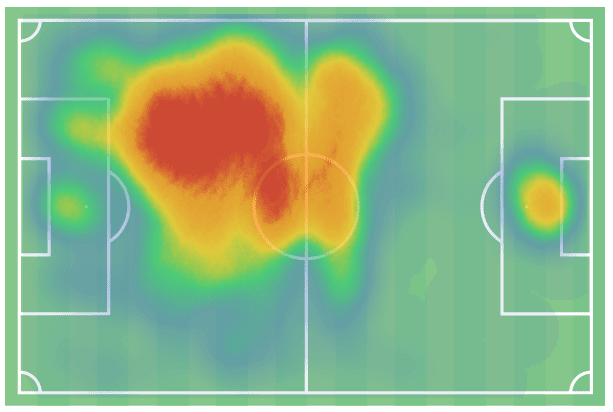
As we can see in her 2021/22 heatmap, Renard is most often deployed at left centre-back in a back four in France’s 4-3-3 or 4-1-4-1 while she is also used in a similar role, in similar formations, for Lyon. She has also played the middle of three in a 3-5-2 for her club on occasion. Defensively, Renard is a good organiser, communicating threats to her teammates.
She is an aggressive, front-foot defender, anticipating the opponent’s intentions well and swiftly moving in to intercept before passes reach their intended targets. If opponents do get the first touch, Renard is very effective in duels, as seen in her data profile. She shows controlled aggression, looking to get a foot or leg in at the earliest opportunity to steal possession.
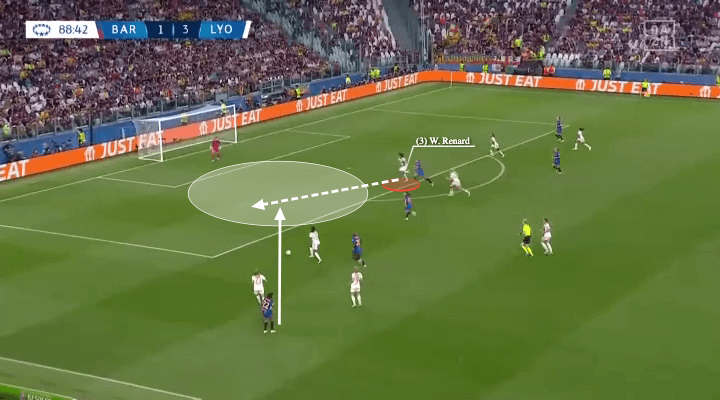
As we can see in this example from the Women’s Champions League final, despite being deep into stoppage time and the game effectively over, Renard still defends proactively, reading the forward pass and moving into midfield to engage. She shapes her body well to get her left foot to the ball around the side of the intended recipient with her touch picked up by her teammate in midfield.
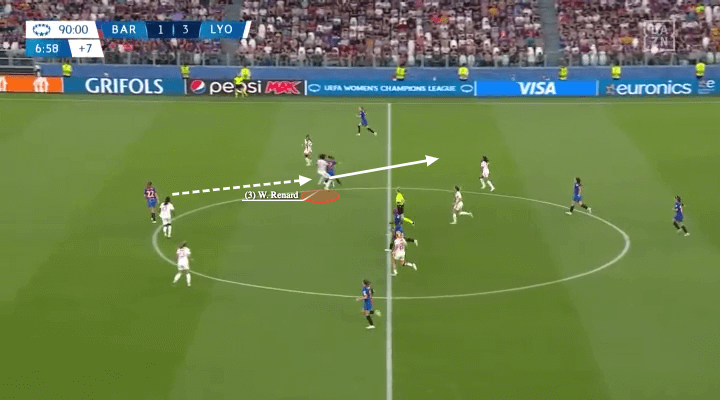
Renard has an excellent understanding of depth and distances, covering spaces effectively, as seen in another example from the final against Barcelona. Here, the Barcelona player has played a through ball in behind on the left side. Renard has spotted the danger early and quickly moves across, matching the run of the intended recipient and blocking any direct route to the goal.
Transitions
France will likely play a high line as they will look to dominate the ball in most games of the tournament — something Renard is more than used to with her all-conquering Lyon team. If they do use a high line and look to win the ball back high up the pitch in transitions, then this will be something Renard will be more than comfortable with.
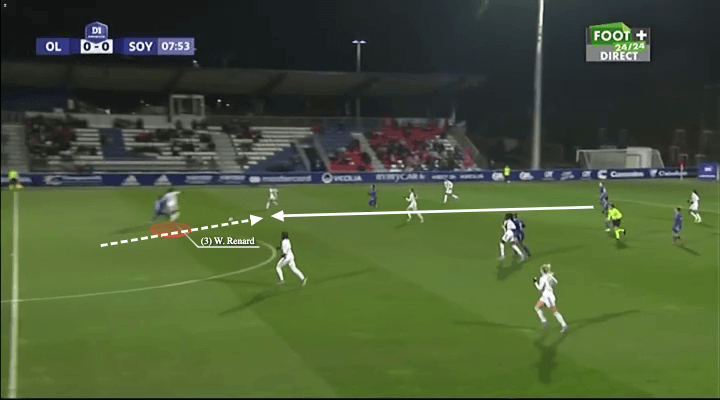
Aggressive in transition phases, Renard uses her speed and physicality to quickly win the ball back. Here we see an example in Lyon’s home game against Soyaux in the Division 1 Féminine. The ball is turned over on the edge of the Soyaux box and they play a direct forward pass. Renard reads the pass and aggressively steps up, using her pace and power to win the ball back in front of the attacker. She then releases a pass out wide into the final third, which puts Lyon back on the attack immediately.
If the opposition attempt to get in behind during a transition, Renard has the speed and power to cover spaces, matching most attackers to either get a foot or a leg in or shaping her imposing frame to usher them out into wide areas near the touchline, such as in the following example in a game against rivals PSG.
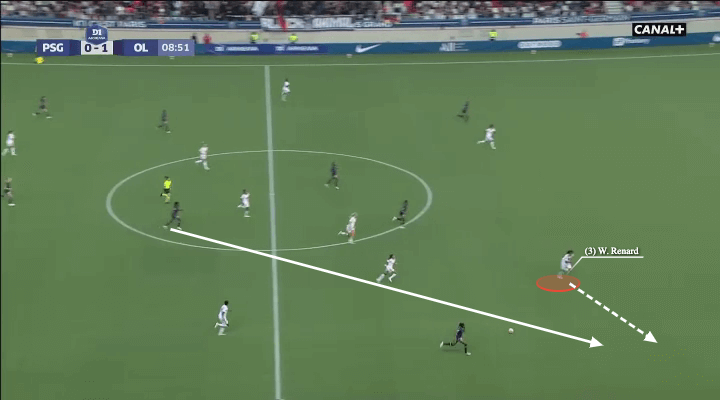
Attacking Phase
Renard will likely have a key role in France’s build-up, starting and even leading attacks from the back.
As we see in her data profile, Renard is very much a ball-playing centre-back, underlined by her high percentile ranks for key possession metrics such as progressive passes and passes to the final third. Calm and composed in possession, Renard protects the ball well when under pressure.
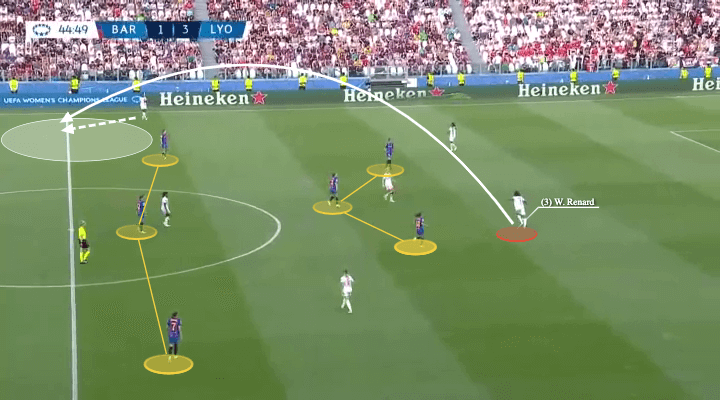
Renard can produce accurate passes, particularly diagonals, over distance into wide, advanced areas that release her teammates into space, as we can see in the above example. Here she has shifted the ball onto her stronger right and plays a long pass out into the wide right area, taking out two lines of defence and giving the right-back possession in a position where she can attack the Barcelona backline.
She is also capable of stepping up into midfield to draw out opponents who may sit deeper. Once she has released the ball she will quickly drop into a position to offer another passing lane if they need to rebuild.
Renard is a big threat from attacking set-pieces with her height and strength a big advantage in the opposition box. Often taking up a position towards the back post to head back across goal, as seen in the next example of her crucial goal against PSG in the Champions League.
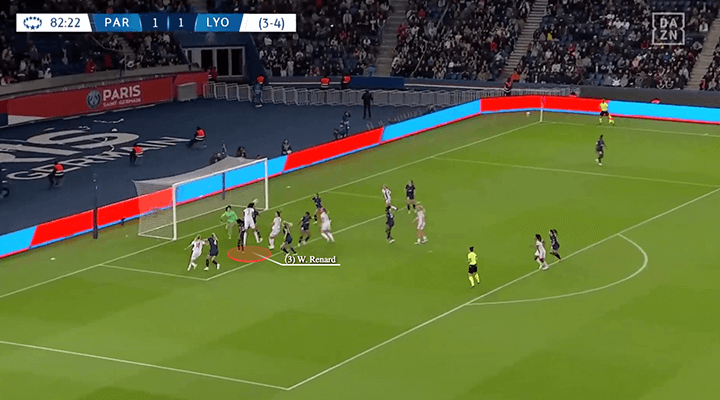
Even if the delivery is not of the best quality, Renard can still use her excellent heading technique to make the most of them. As seen in the next example. Here, the ball is sent towards the front post while swinging away from her. However, Renard adjusts her body to glance the ball over the goalkeeper.
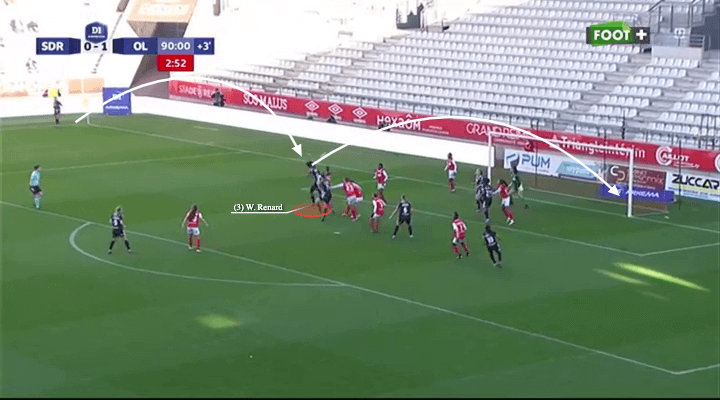
Renard is such a presence in the box that even if she is not found with the delivery, she draws the attention of opposition defenders, creating space for others to exploit.
Physical Profile
Renard is a towering presence on the pitch at 6’2” and 70kg. She has a relatively slender frame but is physically strong with explosive power that helps her challenge aggressively in duels.
Given her size, she is pacey both on and off the ball and has good acceleration as well as mobility, the latter of which allows her to change direction quickly.
She also has excellent endurance, as we saw in one of the first examples where she was still powerfully winning duels late on in a match.
Conclusion
Captaining her country to a European championship title would be a crowning achievement for a player who has been a dominant presence in the women’s game in every sense.
With well-documented issues ahead of the tournament, many will be expecting France to stumble this summer. However, with Renard leading the way there is still a good chance of Les Blues making a big impact in England this July.

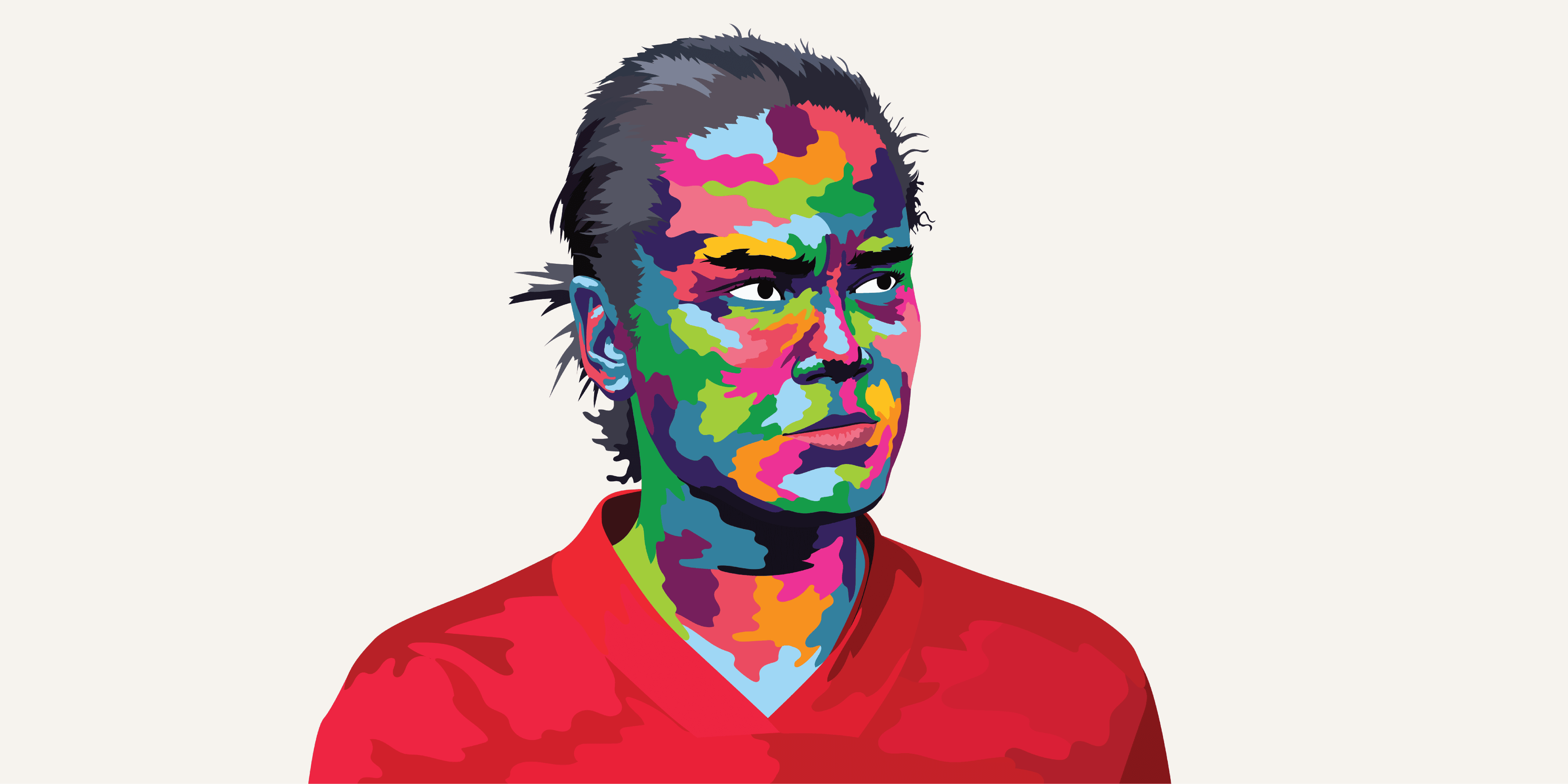



Comments